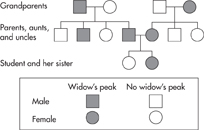Standardized Test Prep
Multiple Choice
Which of the following disorders can be observed in a human karyotype?
colorblindness
trisomy 21
cystic fibrosis
sickle cell disease
Which of the following disorders is a direct result of nondisjunction?
sickle cell disease
Turner's syndrome
Huntington's disease
cystic fibrosis
A woman is homozygous for A− blood type. A man has AB− blood type. What is the probability that the couple's child will have type B− blood?
0%
50%
75%
100%
Cystic fibrosis is a genetic disorder caused by a
single base substitution in the gene for hemoglobin.
deletion of an amino acid from a chloride channel protein.
defective gene found on the X chromosome.
trisomy of chromosome 21.
The technique used to separate DNA strands of different lengths is
gel electrophoresis.
shotgun sequencing.
restriction enzyme digestion.
bioinformatics.
The study of whole genomes, including genes and their functions, is called
bioinformatics.
information science.
life science.
genomics.
DNA can be cut into shorter sequences by proteins known as
haplotypes.
polymerases.
restriction enzymes.
restriction fragments.
Questions 8–9
A student traced the recurrence of a widow's peak hairline in her family. Based on her interviews and observations, she drew the pedigree shown below.

Which pattern of inheritance is consistent with the pedigree?
sex-linked inheritance
complete dominance
codominance
multiple alleles
What are the probable genotypes of the student's parents?
Mother—Ww; Father—ww
Mother—ww; Father—ww
Mother—WW; Father—Ww
Mother—Ww; Father—Ww
Open-Ended Response
Explain how the allele for sickle cell disease, which is a harmful allele when a person is homozygous, can be beneficial when a person is heterozygous.
| Question | 1 | 2 | 3 | 4 | 5 | 6 | 7 | 8 | 9 | 10 |
|---|---|---|---|---|---|---|---|---|---|---|
| See Lesson | 14.1 | 14.2 | 14.1 | 14.2 | 14.3 | 14.3 | 14.3 | 14.1 | 14.1 | 14.2 |
Table of Contents
- Formulas and Equations
- Applying Formulas and Equations
- Mean, Median, and Mode
- Estimation
- Using Measurements in Calculations
- Effects of Measurement Errors
- Accuracy
- Precision
- Comparing Accuracy and Precision
- Significant Figures
- Calculating With Significant Figures
- Scientific Notation
- Calculating With Scientific Notation
- Dimensional Analysis
- Applying Dimensional Analysis




